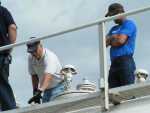Ethanol fuel demands special care

Ethanol.
It's the fuel we use in our cars and a boost for local farmers and corn prices.
But ethanol is also volatile and if not treated properly, it can put first responders and local emergency personal in jeopardy.
Nearly 50 firemen, hazmat, paramedics, EMTs law enforcement, distributors and environmental personal and community leaders attended the Nebraska TRANSCAER training tour that focused on ethanol emergencies when it stopped in McCook Saturday.
McCook's railyard was the second stop of seven that were planned across the state.
The tour was put on to help prepare emergency responders and community leaders to manage hazardous materials incidents including those involving the production and shipping of ethanol.
With more and more ethanol plants developing in the area, traffic whether on the railway or highway is increasing. The TRANSCAER tour provided hands-on training with actual rail tank cars and equipment.
Ethanol is first transported as corn to refineries from local fields. A bushel of corn weighs 56 pounds, which results in about 2.8 gallons of ethanol, 17 pounds of distiller's grain, which can be fed to livestock and 18 pounds of carbon dioxide.
The C02 is also remanufactured. It can be carbonized for soda or returned to the oilfield to be used in the secondary recovery process.
Ethanol begins as a chemical or corn liquor, and is approximately 180-200 proof when broken down at the plant.
It can give a person that drunk feeling if they are around it too long. During an emergency situation, hazmat personnel and emergency responders have the difficult task of finding what kind of chemical is in the tank and treating it with the appropriate tools.
Ethanol is actually a polar solvent. The polar means it will mix with water and solvent means it is not compatible and reactivates with other chemicals.
Gasoline is mixed later at the terminals and denatures the ethanol, then allowing it to be put into station pumps and cars. When lit on fire, the gasoline actually ignites into red -orange flames, while the ethanol flame is clear and hot. Although it may seem the fire is out, the ethanol can still be burning and injury first responders.
In some instances, such as an ethanol fire, water would not put the fire out, but would increase it because ethanol is a polar solvent and bums cleaner and hotter when mixed with water. Although foam would be the quickest way to fight the fire, only certain foams would knock this fire down rapidly.
During the training session, emergency personal learned which foams would be better suited for the ethanol base fires and what to expect from the clear burning gases.
They also toured the railcars, examining the inside of a tanker and the locomotive, learning of the hidden dangers that may results from a derailment or train accident.
Personnel also learned how to be safe themselves, whether enroute to an accident or responding to a spill.
The program gave information and guidance to personnel when the need arises to manage and contain hazardous materials incidents. TRANSCAER is a voluntary, nationwide community outreach program that assists communities to prepare for and respond to a possible hazardous material transportation incident.
Volunteers consisted of representatives from chemical producers, distributors, railroads, tank truck shippers, first responders and government agencies.
